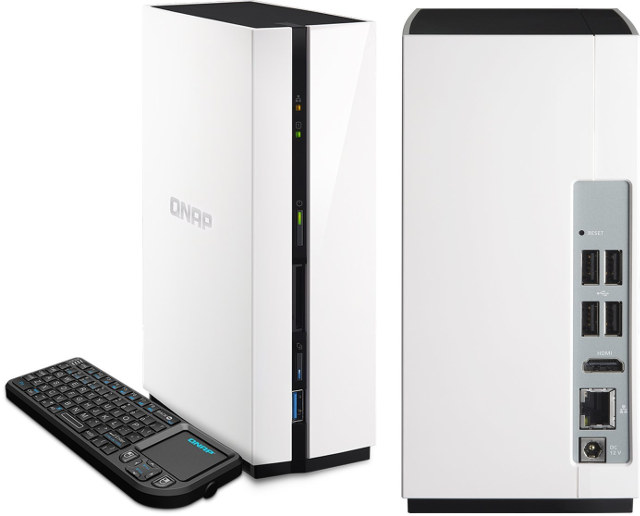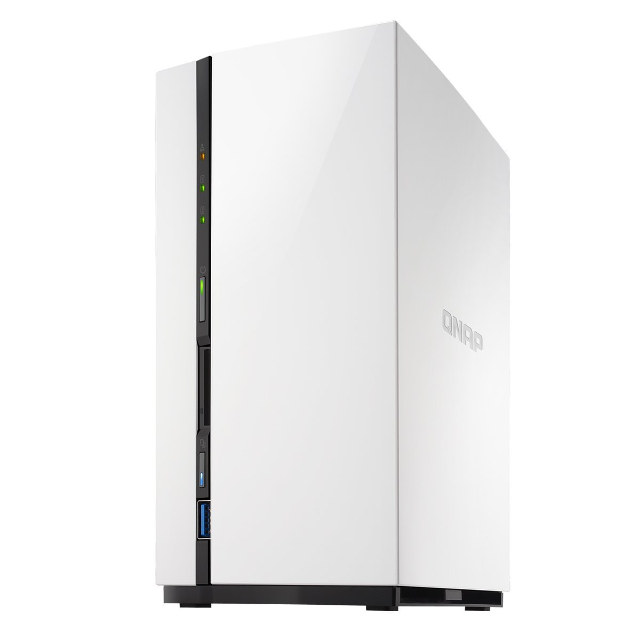QNAP has recently launched two network attached storage (NAS) devices with TAS-168 and TAS-268 that are based on Realtek RTD1195 dual core processor, and happen to run Android along side the company’s Linux based QTS operating system, and respectively have one and two bays for 2.5″ or 3.5″ hard drives.

QNAP TAS-168 and TAS-268 specifications:
- SoC – Realtek RTD1195 dual core ARM Cortex A7 processor @ 1.1 GHz with Mali-400MP2 GPU
- System Memory – 2 GB DDR3
- Storage
- 4 GB eMMC and SD card slot
- TAS-168 – 1x 2.5″ or 3.5″ SATA @ 3Gbs
- TAS-268 – 2x 2.5″ or 3.5″ SATA @ 3Gbs
- Video and Audio Output – HDMI port
- Connectivity – Gigabit Ethernet
- USB – 1x USB 3.0, 4x USB 2.0 host ports
- Misc – IR receiver, LEDs for HDD, LAN, status, and USB, buttons (Power, reset, USB copy)
- Power – TAS-168 – 12V/3A (36W) power adapter; TAS-268 – 12V/5A (60W) power adapter
- Power consumption
- TAS-168 – HDD sleep mode: 1.6W; Active typ. : N/A
- TAS-268 – HDD sleep mode: 5.4W; Active typ. : N/A
- Dimensions
- TAS-168 – 187.7 x 60 x 125 mm
- TAS-268 – 187.7 x 90 x 125 mm
- Weight – TAS-168 – 560 grams; TAS-268 – 700 grams

The internal hard drive will be formatted to EXT-4, while the USB interfaces support EXT-3, EXT-4, NTFS, FAT32 and HFS+ file systems. The performance is said to be 60MB/s and 80 MB/s for repetitively uploading and downloading files from a Windows machine. TAS-268 also support RAID-1, RAID-0, and JBOD configurations. You can find more details on QNAP product sheet.
I previously reviewed an RTD1195 TV box, and Gigabit performance with iperf was about 640 and 750 Mbps in dual duplex mode, and USB 3.0 read speed maxed out to 44.52 MB/s, both of which are pretty decent numbers for TV boxes, but possibly a little on the low side for a NAS. Performance of the system under Android was however sluggish, but the system only had 1GB RAM which would get apps quickly killed, and QNAP NAS should run a bit more smoothly thanks to 2GB RAM. However, the 4GB eMMC flash will quickly fill up if you start installing apps. I could not find reviews yet, but this quick installation guide will show you what you can expect to receive and how to setup the NAS.
Both NAS sells on Amazon US with TAS-168 and TAS-268 going for respectively $199.99 and $249.99 without hard drives. A few more details may also be found in QNAP Android NAS page.
Thanks to Gabe for the tip!

Jean-Luc started CNX Software in 2010 as a part-time endeavor, before quitting his job as a software engineering manager, and starting to write daily news, and reviews full time later in 2011.
Support CNX Software! Donate via cryptocurrencies, become a Patron on Patreon, or purchase goods on Amazon or Aliexpress




